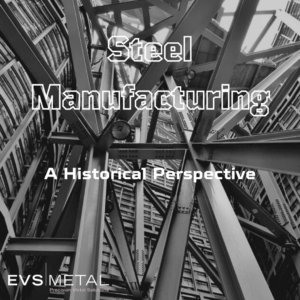
Steel is one of the most common metals from which EVS fabricates parts and products. Archeologists and historians believe that steel has been being produced for almost 4000 years; this makes sense, as that puts the timeline at the beginning of the Iron Age — iron being the primary element used to manufacture steel.
The history of steel is long and fascinating. While we have no idea exactly who it was that actually “invented” steel, examining its origin and viewing its production and implementation from its earliest days can help give some context around why exactly it is that steel has been incredibly important to multiple civilizations through the centuries, and remains so to this day.
The Beginnings of Steel
Starting in the 13th century BC, archeologists have found evidence that blacksmiths were the first to begin to synthesize steel. Like many inventions, it was likely a happy accident, the result of iron being left too long in coal furnaces that contain high levels of carbon, which is a component of steel. The carbon made the iron stronger, harder and more durable.
About 700 years later, in the 6th century BC, “wootz” steel was born in India, which is a beautifully textured metal that is still sought after to this day. “Wootz” steel is the result of combining wrought iron and charcoal during the smelting process. 600 years later (around 300 AD), India’s neighbor China began to produce steel in true mass quantities — the first country to do so. Damascus steel — a very hard type of steel primarily used for sword or knife blades due to its ability to be honed to a razor-like edge — made its debut in the Middle East in the 11th century.
Steel in the 1700-1800s
The 18th century brought a number of inventions and disruptions that would greatly impact the evolution of steel. These include the invention of the first successful steam engine, the development of the crucible steel technique, the introduction of steam power into steel mills, and the invention of the steel roller.
The 1800s, however, were even more vital to steel’s eventual rise to the place it holds today around the world. This century ushered in the American agricultural boom of the 1830s; the introduction of the Bessemer process in 1855 — the first inexpensive industrial process for the mass production of steel from molten iron; and the invention of the open-hearth furnace in 1865. Just a few years later, the end of the American Civil War led to enormous growth in the U.S.’ production of steel. This same period saw the invention of tungsten steel — a type of air-hardening steel — by Robert Mushet. This meant that for the first time, steel wouldn’t need to be “quenched” before it hardened, a huge advance for the industry.
Steel from the 1900s-Today
The open-hearth process of steel production that was invented in the mid-1800s eventually made steel both less expensive to make and of higher quality. This directly contributed to the Industrial Revolution, much of which can be credited to capitalists and industrialists like Charles Schwab and Andrew Carnegie. In fact, when Andrew Carnegie founded US Steel Corporation in 1901, it was the first company ever launched with an initial valuation of over $1 billion.
The 20th century also ushered in the age of the automobile, and was greatly fueled by two World Wars that made steel an absolute necessity to many governments well into the 1940s. This boom was aided by the invention of electric arc furnace steelmaking, a process that by the early 1940s was being used for the vast majority of steel manufacturing. Finally, in the 1960s, Oxygen steelmaking made its debut as an even more efficient process, leading to the closure of the last remaining open-hearth facilities by the very beginning of the 21st century, in 2001.
Want to know more about how EVS Metal’s steel fabrication capabilities can help with your next project? Get a quote online, or call us at 1-888-9EVSMET.





